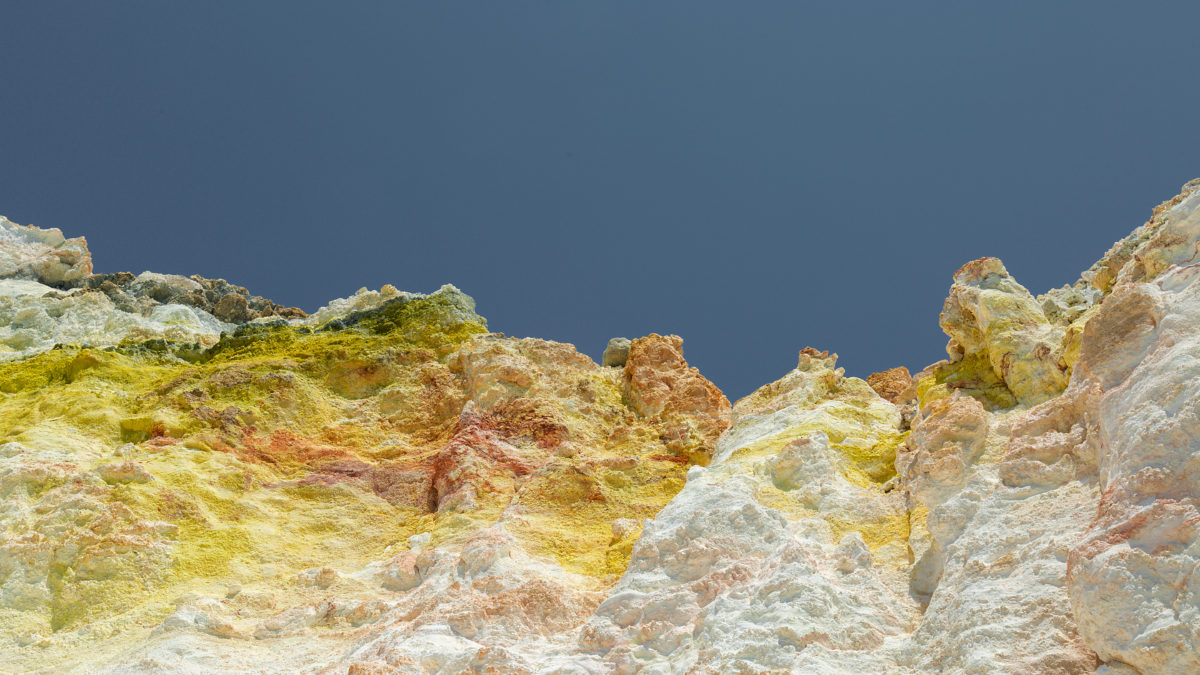Quando sei un fotografo, quando di viaggi ne hai fatti un sacco, quando sei difficile da sorprendere. Quando vai in vacanza con amici che non te la dicono tutta. Diario di un flusso di coscienza durato una vacanza, e delle immagini di quel preciso momento.
Sono atterrato a Milos, senza sapere assolutamente nulla dell’isola, volevo godermi la vista delle sue famose spiagge senza banali spoiler.
So che viene spesso chiamata “l’isola dei colori”: pur sforzandomi, non riesco a non avere aspettative alte sulle spiagge che vedrò.

Quel che resta del primo giorno dopo l’atterraggio lo trascorro in solitaria per le vie di Adamas, ricongiungendomi con la cucina greca, mentro aspetto i miei amici del Nord e il mio amore.

Quando finalmente ci riuniamo, facciamo una capatina a Klima con brindisi al tramonto per inaugurare la vacanza, chiudendo una giornata tutto sommato intensa.
La mattina seguente l’abbiamo dedicata alla scalata per arrivare “alla chiesa in cima alla collina”, approfittando delle nuvole e del forte vento -la fatica, smorzata dalle molte pause che ho imposto al gruppo per grattare dietro le orecchie i molti gatti incontrati lungo il percorso- che rendono quella che si rivela a tutti gli effetti un’arrampicata, se non altro fattibile.

Conquistata la vetta ammiriamo la vista girando intorno al casotto bianco, scattiamo qualche foto che sappiamo già non pubblicheremo mai e scendiamo di nuovo a valle.
Una volta appurato che il Sole avrebbe retto, visitiamo finalmente la prima spiaggia. Ne scegliamo tatticamente una munita di un buon ristorante e partiamo. Una volta arrivati, riserviamo un tavolo un’ora dopo e ci fiondiamo in acqua, un bagno blu e turchese, circondato da un muro di roccia arancione. Bello. Non bellissimo, ma bello. Il ristorante, invece, quello si che è eccezionale.
Probabilmente il forte vento ereditato dalla mattina non ci fa godere la sabbia grigia striata di bianco, l’impossibilità di sdraiarci non ci ha fatto rilassare. Paliochori, insomma, non ci coinvolge.

Il giorno dopo non ci sono scuse. Il vento non si è placato ma il cielo è un’unica lisca lastra di quell’azzurro che solo in Grecia vedrai. Stabiliamo quindi intorno ad un vassoio carico di deliziosi Pitarakia e forse troppi caffè freddi schiumati, che quel giorno avremmo visto almeno due spiagge.
Illudendoci di eludere il principio di monsone palesemente in atto sull’isola, puntiamo la costa Sud, direzione Tsigrado.
Inutile dire che qui il vento era, se possibile, ancora più forte.
La spiaggia si prospetta interessante, scendo dalla macchina e cammino su un basso altopiano a strapiombo sul mare. Tenendo gli occhiali da sole il più possibile vicino agli occhi mi affaccio su una serie di piccole baie celesti dall’aria molto invitante, la superficie dell’acqua dolcemente increspata dal vento.
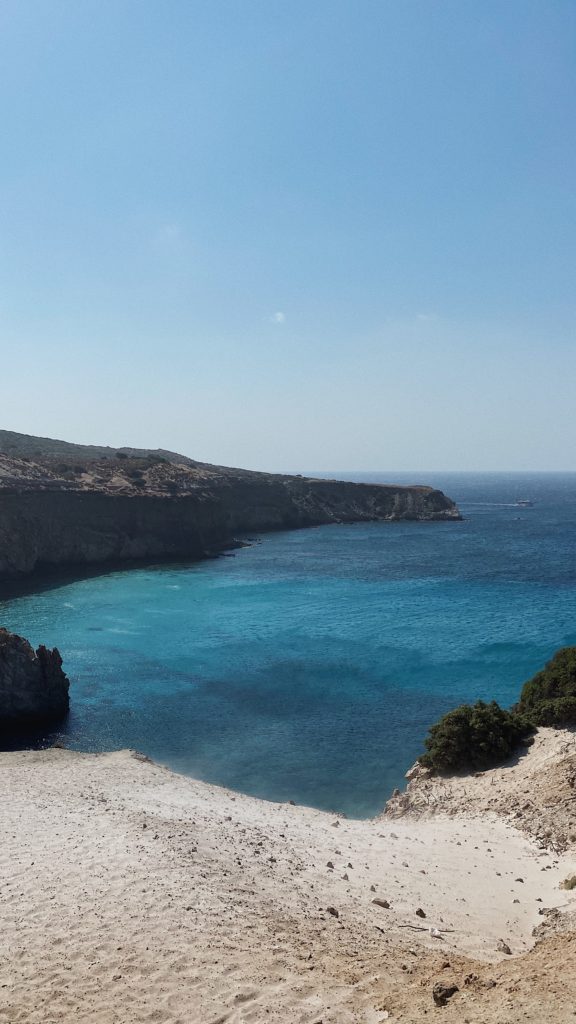
Mi guardo intorno attraverso le onde di polvere bianca alla ricerca del punto di accesso alla meraviglia sotto di me, ma non trovo nulla. Vedo i miei amici ridere indicandomi la direzione giusta e capisco troppo tardi di essere stato fregato.
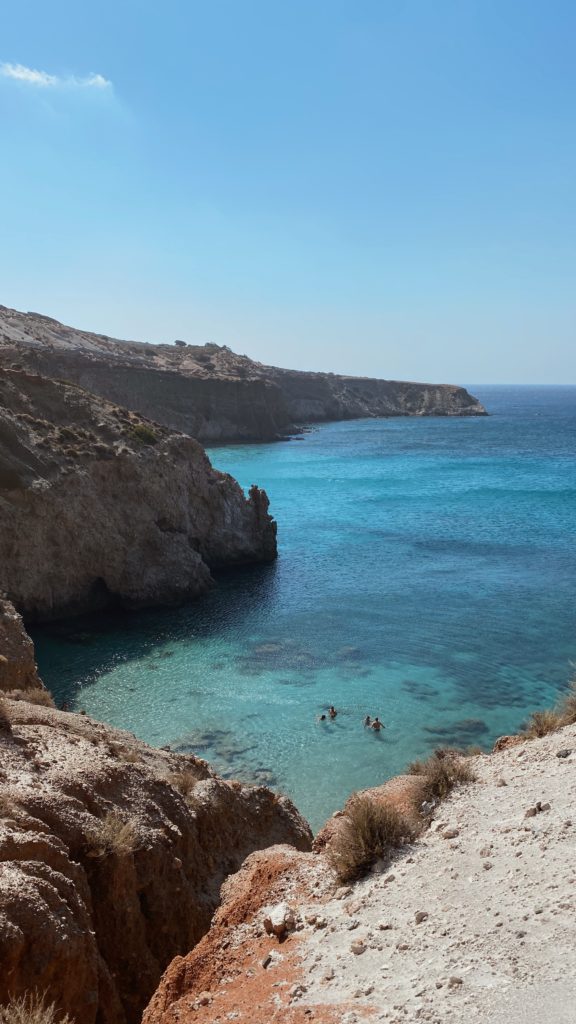
Durante il brainstorming della mattina infatti, i simpaticoni con cui sono in viaggio hanno volontariamente omesso il dettaglio, tutt’altro che trascurabile, che per riuscire ad arrivare a livello dell’acqua bisogna scendere lungo una scala a pioli fatta di legno.
A occhio sembra essere stata messa lì da Zeus in persona qualche secolo prima in un giorno in cui si sentiva particolarmente incline all’omicidio.

Da qui, avremmo dovuto camminare lungo uno stretto corridoio di roccia.
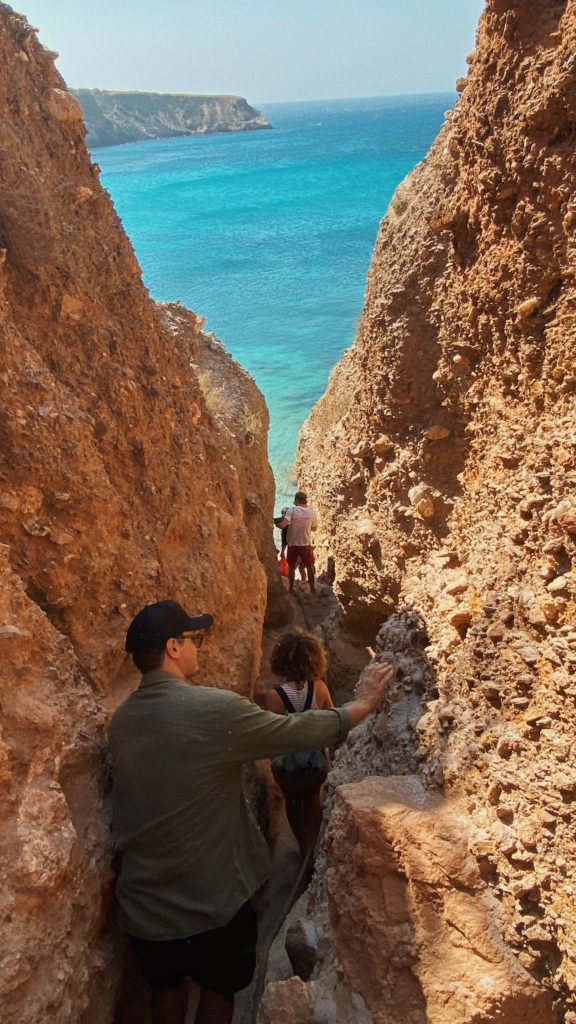
Quindi, calarci lungo una seconda scala alta 4 metri, il tutto tenendosi dall’inizio alla fine ad un’unica lunghissima fune, coetanea della prima scala.
Mentre familiarizzo con il percorso valuto che probabilmente sarò troppo impegnato a non morire per provare le vertigini che in genere mi assalgono anche solo salendo su una sedia.

Tutto sommato la discesa va abbastanza bene. Procedo marziale fino alla parte con la fune, vivendo un solo terrificante momento, quando il francese dopo di me pensa bene di fermarsi in cima alla scala per farsi un selfie (controluce, tra l’altro) generarando una piccola valanga che mi piove addosso mentre sono semi sospeso a 4 metri da terra.
Atterro finalmente sulla calda, sicura spiaggia e mi guardo intorno. Ammetto di restare un po’ deluso. Sono al centro di in un semicerchio quasi perfetto di sabbia chiara su cui il sole batte implacabile. Pur non essendo piena la baia sembra affollata, procediamo a zigzag puntando una porzione di spiaggia libera dove posiamo i teli e andiamo a fare un bagno.
L’acqua è trasparente e fresca come quasi ovunque in Grecia, ma non regge con l’aspettativa dei racconti meravigliosi che ho sentito su Milos e la sua incredibile varietà di paesaggi. Inizio seriamente a domandarmi se non sia diventato un esigente rompicoglioni.
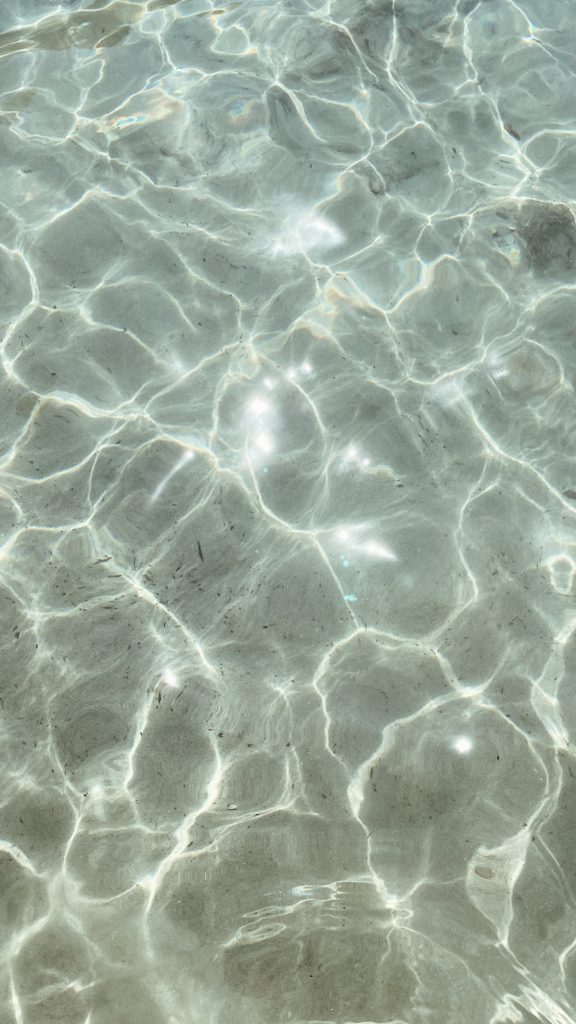
Nel corso dell’ora che trascorriamo con l’acqua che ci accarezza i fianchi assistiamo alla discesa di altri temerari beachers. La proporzione tra chi va e chi arriva è considerevolmente inversa e decidiamo di spostarci. Direzione Fyriplaka.
In macchina mi dicono essere una delle spiagge più famose dell’isola, ma cerco di non crearmi aspettative per non rimanere nuovamente insoddisfatto.
Scendiamo dalla macchina solo per scoprire che il vento non solo ci ha inseguiti, ma è addirittura aumentato. Procediamo lungo il sentiero sterrato praticamente piegati in due cercando di non restare accecati dalla polvere, colgo solo di sfuggita la lunga lingua di sabbia che fa da spartiacque tra il mare e le montagne che si alzano imponenti direttamente dalla spiaggia.
Arrivati a riva iniziamo a camminare, tutti silenziosamente concordi nel mettere quanta più distanza possibile tra noi e lo stabilimento balneare che inaugura la spiaggia. C’è decisamente troppa gente e l’acqua non è più stupefacente di una qualsiasi spiaggia greca.
Medito sul mio disappunto mentre continuamo ad avanzare, allontanandoci sempre di più dal genere umano e dalla radio greca (proprio non ci siamo).
Il vento è implacabile, la sabbia disseminata di grosse rocce che spuntano come iceberg rendendo praticamente impossibile camminare guardando qualsiasi altra cosa che non siano i miei piedi.
Mentre cammino realizzo che sono piegato a 45 gradi da più di dieci minuti e non ho praticamente idea di dove mi trovi. Senza fermarmi mi raddrizzo e strizzando gli occhi guardo in su.
Ed è stato allora che ho visto le montagne.
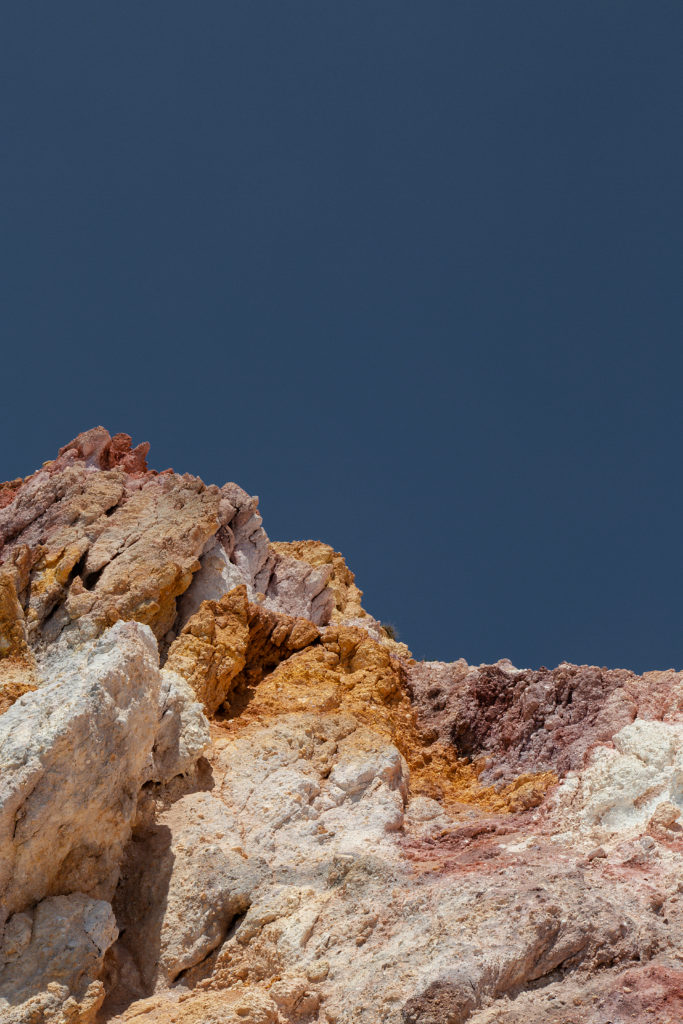









Non so per quanto tempo ho fatto avanti e indietro su quel bagnasciuga, so solo che a un certo punto sono partito per un viaggio dentro al viaggio, un momento di profondo imprinting con l’Isola che mi ha insegnato a guardarla.
La spiaggia dove è stato scattato l’editoriale si chiama Fyriplaka, e si trova nella parte sud dell’isola di Milos.
ENGLISH VERSION
When you are a photographer, when you have done a lot of travelling, when you are hard to surprise. When you go on holiday with friends who don’t tell you everything. Diary of a stream of consciousness that lasted one holiday, and of the images of that precise moment.
I landed in Milos, knowing absolutely nothing about the island, I wanted to enjoy the view of its famous beaches without trivial spoilers.
I know that it is often called “the island of colours”: no matter how hard I try, I can’t help but have high expectations of the beaches I will see.
What remains of the first day after landing I spend alone in the streets of Adamas, reconnecting with Greek cuisine while waiting for my friends from the North and my love.
When we finally reunited, we made a detour to Klima with a toast at sunset to inaugurate the holiday, ending a day that was, all in all, intense.
The following morning we dedicated it to the climb to get to “the church at the top of the hill”, taking advantage of the clouds and the strong wind -the fatigue dampened by the many breaks I imposed on the group to scratch behind the ears of the many cats encountered along the way- which made what turned out to be to all intents and purposes a climb, if only feasible.
Having reached the summit, we admired the view as we circled around the white hut, took a few photos that we already knew we would never publish, and descended again to the valley.
Once we knew that the sun would hold out, we finally visited the first beach. We tactically choose one with a good restaurant and set off. Once we get there, we reserve a table an hour later and plunge into the water, a blue and turquoise bath, surrounded by a wall of orange rock. Nice. Not beautiful, but nice. The restaurant, on the other hand, is exceptional.
Probably the strong wind inherited from the morning didn’t allow us to enjoy the grey sand streaked with white, the impossibility of lying down didn’t make us relax. Paliochori, in short, does not involve us.
The next day there are no excuses. The wind hasn’t died down but the sky is a single slab of that blue you only see in Greece. So we decide, around a tray full of delicious Pitarakia and perhaps too many cold foamed coffees, that we will see at least two beaches that day.
Deluding ourselves that we could avoid the monsoon, which is clearly in force on the island, we head for the south coast, in the direction of Tsigrad.
Needless to say, the wind here was, if possible, even stronger.
The beach looks interesting, I get out of the car and walk on a low plateau overlooking the sea. Keeping my sunglasses as close to my eyes as possible, I look out over a series of small blue bays with a very inviting air, the surface of the water gently rippled by the wind.
I look around through the waves of white powder for the access point to the wonder below me, but find nothing. I see my friends laughing, pointing me in the right direction, and realise too late that I have been fooled.
During the morning’s brainstorming session, in fact, the nice people I’m travelling with deliberately omitted the detail, which is anything but negligible, that in order to get to water level you have to go down a wooden ladder.
By the look of it, it seems to have been put there by Zeus himself a few centuries earlier on a day when he felt particularly inclined to murder.
From here, we would have to walk down a narrow corridor of rock.
Then, rappel down a second 4-metre-high ladder, all while holding on from start to finish to a single very long rope, the same age as the first ladder.
As I familiarise myself with the route, I realise that I will probably be too busy trying not to die to feel the vertigo that usually assails me even if I climb up a chair.
All in all, the descent goes quite well. I proceed martial until the part with the rope, experiencing only one terrifying moment, when the Frenchman after me decides to stop at the top of the ladder to take a selfie (against the light, by the way) generating a small avalanche that rains down on me while I am semi-suspended at 4 meters from the ground.
I finally land on the warm, safe beach and look around. I admit to being a little disappointed. I am in the middle of an almost perfect semicircle of pale sand on which the sun beats down relentlessly. Although it is not full, the bay seems to be crowded, so we zigzag to a portion of the free beach where we put down our towels and go for a swim.
The water is transparent and cool as almost everywhere in Greece, but does not hold with the expectation of the wonderful stories I have heard about Milos and its incredible variety of landscapes.
During the hour we spend with the water caressing our hips, we witness the descent of other daring beachers. The ratio of those who go to the beach to those who come is considerably inverted and we decide to move on. Direction Fyriplaka.
In the car they tell me it is one of the most famous beaches on the island, but I try not to create expectations so as not to remain unsatisfied again.
We get out of the car only to discover that the wind has not only chased us, but has actually increased. We proceed along the dirt path, practically bent in two, trying not to be blinded by the dust, and I only catch a glimpse of the long strip of sand that acts as a watershed between the sea and the mountains that rise imposingly directly from the beach.
When we get to the shore we start walking, all silently agreeing to put as much distance as possible between us and the bathing establishment that opens the beach. There are far too many people and the water is no more stunning than any Greek beach.
I meditate on my disappointment as we continue to advance, moving further and further away from mankind and Greek radio.
The wind is relentless, the sand littered with large rocks sticking out like icebergs making it virtually impossible to walk looking at anything other than my feet.
As I walk I realize that I have been bent at 45 degrees for more than ten minutes and I have practically no idea where I am. Without stopping, I straighten up and squinting, I look up.

